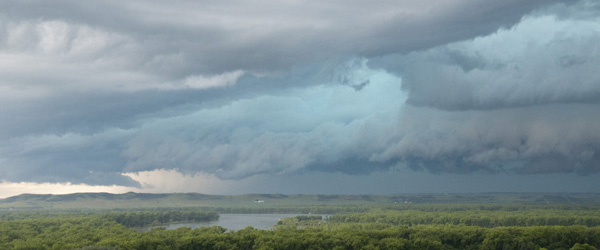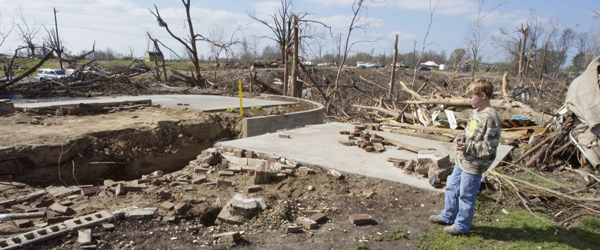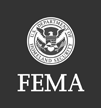 Before a Tornado
Before a Tornado
- To begin preparing, you should build an emergency kit and make a family communications plan.
- Listen to NOAA Weather Radio or to commercial radio or television newscasts for the latest information. In any emergency, always listen to the instructions given by local emergency management officials.
- Be alert to changing weather conditions. Look for approaching storms.
- Look for the following danger signs:
- Dark, often greenish sky
- Large hail
- A large, dark, low-lying cloud (particularly if rotating)
- Loud roar, similar to a freight train.
- If you see approaching storms or any of the danger signs, be prepared to take shelter immediately.
Quick facts you should know about tornadoes:
- They may strike quickly, with little or no warning.
- They may appear nearly transparent until dust and debris are picked up or a cloud forms in the funnel.
- The average tornado moves Southwest to Northeast, but tornadoes have been known to move in any direction.
- The average forward speed of a tornado is 30 mph, but may vary from stationary to 70 mph.
- Tornadoes can accompany tropical storms and hurricanes as they move onto land.
- Waterspouts are tornadoes that form over water.
- Tornadoes are most frequently reported east of the Rocky Mountains during spring and summer months.
- Peak tornado season in the southern states is March through May; in the northern states, it is late spring through early summer.
- Tornadoes are most likely to occur between 3 pm and 9 pm, but can occur at any time.
Familiarize yourself with these terms to help identify a tornado hazard:
Tornado Watch - Tornadoes are possible. Remain alert for approaching storms. Watch the sky and stay tuned to NOAA Weather Radio, commercial radio or television for information.
Tornado Warning - A tornado has been sighted or indicated by weather radar. Take shelter immediately.
During a Tornado
If you are under a tornado warning, seek shelter immediately! Most injuries associated with high winds are from flying debris, so remember to protect your head.
| If you are in: |
Then: |
|---|
| A structure (e.g. residence, small building, school, nursing home, hospital, factory, shopping center, high-rise building) |
- Go to a pre-designated shelter area such as a safe room, basement, storm cellar, or the lowest building level. If there is no basement, go to the center of an interior room on the lowest level (closet, interior hallway) away from corners, windows, doors, and outside walls. Put as many walls as possible between you and the outside. Get under a sturdy table and use your arms to protect your head and neck.
- In a high-rise building, go to a small interior room or hallway on the lowest floor possible.
- Put on sturdy shoes.
- Do not open windows.
|
| A trailer or mobile home |
- Get out immediately and go to the lowest floor of a sturdy, nearby building or a storm shelter. Mobile homes, even if tied down, offer little protection from tornadoes.
|
| The outside with no shelter |
- Immediately get into a vehicle, buckle your seat belt and try to drive to the closest sturdy shelter.
- If your vehicle is hit by flying debris while you are driving, pull over and park.
- Stay in the car with the seat belt on. Put your head down below the windows; cover your head with your hands and a blanket, coat or other cushion if possible.
- If you can safely get noticeably lower than the level of the roadway, leave your car and lie in that area, covering your head with your hands
- Do not get under an overpass or bridge. You are safer in a low, flat location.
- Never try to outrun a tornado in urban or congested areas in a car or truck. Instead, leave the vehicle immediately for safe shelter.
- Watch out for flying debris. Flying debris from tornadoes causes most fatalities and injuries.
|
After a Tornado
Injury may result from the direct impact of a tornado or it may occur afterward when people walk among debris and enter damaged buildings. A study of injuries after a tornado in Marion, Illinois, showed that 50 percent of the tornado-related injuries were suffered during rescue attempts, cleanup and other post-tornado activities. Nearly a third of the injuries resulted from stepping on nails. Because tornadoes often damage power lines, gas lines or electrical systems, there is a risk of fire, electrocution or an explosion. Protecting yourself and your family requires promptly treating any injuries suffered during the storm and using extreme care to avoid further hazards.
Injuries
Check for injuries. Do not attempt to move seriously injured people unless they are in immediate danger of further injury. Get medical assistance immediately. If someone has stopped breathing, begin CPR if you are trained to do so. Stop a bleeding injury by applying direct pressure to the wound. Have any puncture wound evaluated by a physician. If you are trapped, try to attract attention to your location.
General Safety Precautions
Here are some safety precautions that could help you avoid injury after a tornado:
- Continue to monitor your battery-powered radio or television for emergency information.
- Be careful when entering any structure that has been damaged.
- Wear sturdy shoes or boots, long sleeves and gloves when handling or walking on or near debris.
- Be aware of hazards from exposed nails and broken glass.
- Do not touch downed power lines or objects in contact with downed lines. Report electrical hazards to the police and the utility company.
- Use battery-powered lanterns, if possible, rather than candles to light homes without electrical power. If you use candles, make sure they are in safe holders away from curtains, paper, wood or other flammable items. Never leave a candle burning when you are out of the room.
- Never use generators, pressure washers, grills, camp stoves or other gasoline, propane, natural gas or charcoal-burning devices inside your home, basement, garage or camper - or even outside near an open window, door or vent. Carbon monoxide (CO) - an odorless, colorless gas that can cause sudden illness and death if you breathe it - from these sources can build up in your home, garage or camper and poison the people and animals inside. Seek prompt medical attention if you suspect CO poisoning and are feeling dizzy, light-headed or nauseated.
- Hang up displaced telephone receivers that may have been knocked off by the tornado, but stay off the telephone, except to report an emergency.
- Cooperate fully with public safety officials.
- Respond to requests for volunteer assistance by police, fire fighters, emergency management and relief organizations, but do not go into damaged areas unless assistance has been requested. Your presence could hamper relief efforts and you could endanger yourself.
Inspecting the Damage
- After a tornado, be aware of possible structural, electrical or gas-leak hazards in your home. Contact your local city or county building inspectors for information on structural safety codes and standards. They may also offer suggestions on finding a qualified contractor to do work for you.
- In general, if you suspect any damage to your home, shut off electrical power, natural gas and propane tanks to avoid fire, electrocution or explosions.
- If it is dark when you are inspecting your home, use a flashlight rather than a candle or torch to avoid the risk of fire or explosion in a damaged home.
- If you see frayed wiring or sparks, or if there is an odor of something burning, you should immediately shut off the electrical system at the main circuit breaker if you have not done so already.
- If you smell gas or suspect a leak, turn off the main gas valve, open all windows and leave the house immediately. Notify the gas company, the police or fire departments, or State Fire Marshal's office and do not turn on the lights, light matches, smoke or do anything that could cause a spark. Do not return to your house until you are told it is safe to do so.
Safety During Clean Up
- Wear sturdy shoes or boots, long sleeves and gloves.
- Learn proper safety procedures and operating instructions before operating any gas-powered or electric-powered saws or tools.
- Clean up spilled medicines, drugs, flammable liquids and other potentially hazardous materials.
 FEMA Publications
FEMA Publications
If you require more information about any of these topics, the following resources may be helpful.
Related Websites
Find additional information on how to plan and prepare for a tornado and learn about available resources by visiting the following websites:
Listen to Local Officials
Learn about the emergency plans that have been established in your area by your state and local government. In any emergency, always listen to the instructions given by local emergency management officials.
 Build a Safe Room
Build a Safe Room
Extreme windstorms in many parts of the country pose a serious threat to buildings and their occupants. Your residence may be built "to code" but that does not mean it can withstand winds from extreme events such as tornadoes and major hurricanes. The purpose of a safe room or a wind shelter is to provide a space where you and your family can seek refuge that provides a high level of protection. You can build a safe room in one of several places in your home.
- Your basement
- Atop a concrete slab-on-grade foundation or garage floor.
- An interior room on the first floor.
Safe rooms built below ground level provide the greatest protection, but a safe room built in a first-floor interior room also can provide the necessary protection. Below-ground safe rooms must be designed to avoid accumulating water during the heavy rains that often accompany severe windstorms.
To protect its occupants, a safe room must be built to withstand high winds and flying debris, even if the rest of the residence is severely damaged or destroyed. Consider the following when building a safe room:
- The safe room must be adequately anchored to resist overturning and uplift.
- The walls, ceiling and door of the shelter must withstand wind pressure and resist penetration by windborne objects and falling debris.
- The connections between all parts of the safe room must be strong enough to resist the wind.
- Sections of either interior or exterior residence walls that are used as walls of the safe room must be separated from the structure of the residence so that damage to the residence will not cause damage to the safe room.
Additional information about Safe Rooms available from FEMA:


